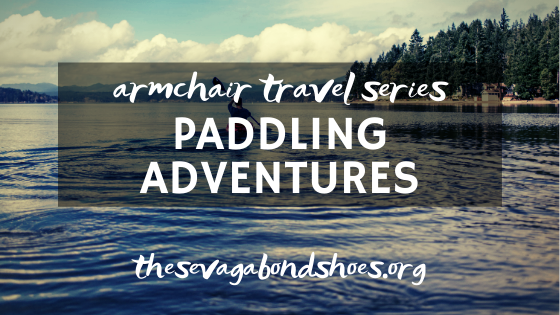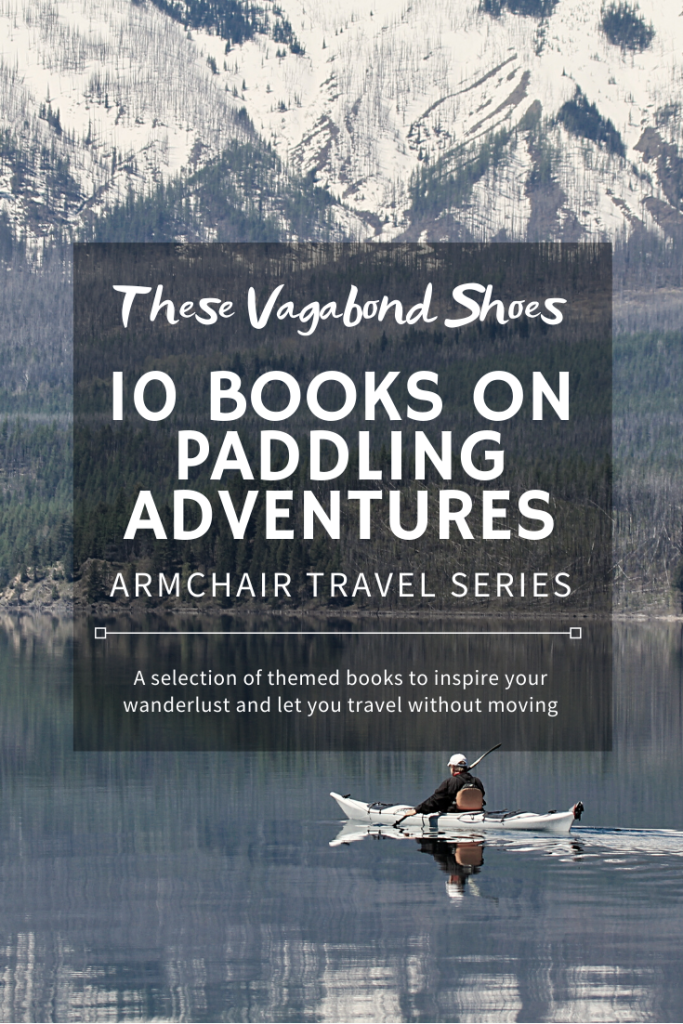This is my selection of the most interesting and inspiring books about paddling adventures around the world.
This edition of Armchair Travel takes to the water in a selection of small craft, in canoes, kayaks and skiffs to explore the world from water level. These accounts of expeditions in small boats are tales of individual adventure on the water, but also embrace the pace of paddle-powered slow travel allowing the history and maritime culture of the regions travelled to unfold for the voyagers.
So whether you’re looking to find motivation to try a new activity, or you’re more than comfortable exploring the world from the waterline, read on for inspiration for making a paddling adventure of your own, or enjoy the vicarious undertakings of seasoned paddlers.
10 of the best books about paddling adventures
Argonauts of the Scottish Isles: Sea-Kayaking Adventures – Robin Lloyd-Jones
A recent re-issue of the Scottish sea kayaking classic Argonauts of the Western Isles, first published in 1974, with five additional chapters featuring more recent paddling tours, Lloyd-Jones shares memorable tales from expeditions solo and with friends through the Inner and Outer Hebrides, Orkney, and Shetland. Woven through the stories of paddling open water in the swell of the Atlantic Ocean, running tidal streams like the awesome Corryvreckan whirlpool, and bivouacking under the stars are thoughts on kayak exploration, local history and wildlife encounters. Find it here.
Kings of the Yukon: One Summer Paddling Across the Far North – Adam Weymouth
The 3,190km (1,980 mile) long Yukon River runs through the wilderness of Canada’s Yukon Territory and Alaska, before reaching the Bering Sea at the Yukon–Kuskokwim Delta on the west coast of Alaska, and is one of the longest salmon runs anywhere in the world. Each year, hundreds of thousands of king (Chinook) salmon migrate upstream to spawn, then die
Weymouth paddles the Yukon from source to sea over the course of two summers, tracing the lifecycle of the salmon and the deep ties the fish have with communities along the river. He explores current and historic cultural and commercial connections, and probes ideas of what the future may hold for both fish and people in the light of climate change, a globalised economy, and fundamental changes to the balance of nature across the region and on a greater scale. It has many parallels with another book I’ve previously enjoyed, Cod by Mark Kurlansky. Buy it here.
Inside: One Woman’s Journey Through the Inside Passage – Susan Marie Conrad
This is Conrad’s account of a 66-day solo kayak expedition through the Inside Passage of the Pacific Northwest region, from Anacortes in Washington State to Juneau, Alaska. Refreshingly for a book of this type by a female writer, the writing focuses mainly on the narrative account of the expedition, the detailed planning and preparation, and the intensive physical preparation Conrad undertakes ahead of the journey, rather than being wholly an introspective memoir on finding oneself through adventure. However the landscapes travelled through and the events of the trip are vividly described, from relentless rain and challenging tidal conditions to spectacular scenery and encounters with native wildlife, which gives this part of the book the feel of a slow-moving meditation on connecting with nature and reflecting on vulnerability while undertaking a gruelling physical and mental challenge. Get it here.
The Survival of the Bark Canoe – John McPhee
This book was first published in 1975, and captures the craftsmanship required to build a traditional First Nations birchbark canoe through a beautiful character profile of Henri Vaillancourt, a self-taught boatbuilder determined not to let the skills be lost. McPhee describes the process in rich detail, from splitting the trees to shape the frame to laying on the bark skin, and hand carving a paddle, and dives into the history of the crafts.
The second part of the book recounts a canoe voyage McPhee takes along with Vaillancourt, teaching him to paddle his own canoes, and a couple of friends through the big woods of Maine, the wilderness traversed by Thoreau around a century before, searching for the birch trees used in the construction of the boats and musing on connections to nature and use of natural resources. Find it here.
Travel by canoe is not a necessity, and will nevermore be the most efficient way to get from one region to another, or even from one lake to another – anywhere.
John McPhee, The Survival of the Bark Canoe
Kabloona in the Yellow Kayak: One Woman’s Journey Through the Northwest Passage – Victoria Jason
A hard-learned lesson in choosing a paddle partner with a similar outlook on life, compatible goals and objectives for an expedition, and a leadership style that suits everyone involved in the undertaking. Over the summers of 1991 to 1994, Jason took part in a 7,500km kayak from Churchill, Manitoba to Tuktoyaktuk on the Beaufort Sea, initially with two companions, Fred Reffler and experienced kayaker Don Starkel. Beset by injury and illness, Reffler pulls out of the expedition early on, and Jason is forced to drop out with extreme fatigue on reaching Gjoa Haven in the second summer. Starkell continued alone before being rescued just a couple of days short of Tuktoyaktuk, close to death and suffering severe frostbite.
Not content with abandoning the expedition, Jason returned in the following summers to complete the journey alone from west to east, paddling from Fort Providence on the Mackenzie River to Paulatuk in 1993, and from Paulatuk to Gjoa Haven in 1994. The book is a testament to Jason’s resilience and tenacity, especially as on setting out in 1991 she had been kayaking for just a year and was still recovering from the second of two strokes. Get it here.
The Pacific Alone: The Untold Story of Kayaking’s Boldest Voyage – Dave Shively
In the summer of 1987, Ed Gillet undertook an awesome challenge, paddling solo and unsupported from Monterrey, California, to the island of Maui, Hawaii, a distance of around 3,700km (2,300 miles). An accomplished paddler and sailor with several previous endurance kayaking expeditions under his belt, navigating by the sun and stars, fixing his position by sextant, he completed the gruelling voyage in 63 days, four days after his food rations had run out. The physical toll of the voyage extended to pounding from the relentless Pacific swell, saltwater sores and sun exposure, and extreme exhaustion from a lack of sleep. Shively builds the remarkable story from Gillet’s expedition logbook and in-depth interviews with Gillet, his wife Katie, and other expedition supporters. Find it here.
The Happy Isles of Oceania: Paddling the Pacific – Paul Theroux
Over the course of a year and a half in the early 1990s, Theroux spent time on fifty-one islands across the Pacific, from the larger islands of New Zealand and Papua New Guinea to less visited further flung specks of land surrounded hundreds of miles of ocean, equipped with just a folding kayak, small tent and sleeping bag. Theroux’s writing is always personal, the lens through which he views his travel experience, and this book reflects on the separation and impending divorce from his wife. This introspection filters into portraits of locals and snapshots of places, filled out with deep dives into the history and culture of the region. Find it here.
Four Corners: A Journey into the Heart of Papua New Guinea – Kira Salak
Salak sets out to traverse the breadth of Papua New Guinea in the mid-1990s, leaving behind the threat of crime and violence in the city to flyover swampy jungle, trek on foot through mountainous highlands, and paddle by dugout canoe through the Sepik River and its tributaries. Her solo journey pushes her to her physical and emotional limits, and she explores the fears and risks faced by women travelling on their own in remote locations, where linguistic and cultural differences create additional challenges to be navigated.
She offers a glimpse into the history, geography, and culture of a lesser-visited area of the world, through the nature of her expedition means these are more of a snapshot view than insights illuminating the lives of people and the relationship they have with place. The narrative is much more about the interior journey Salak undertakes, the compulsion to keep moving through the landscape supporting a spiritual voyage based on the desire to transform herself and find contentment. Get it here.
Paddlenorth: Adventure, Resilience and Renewal in the Arctic Wild – Jennifer Kingsley
Kingsley and five companions set out to make a canoe descent of the Back River (Haningayok / Great Fish River) in Nunavut Territory, taking 54 days to reach the Arctic Ocean. This book is an honest and authentic account of an expedition through a wilderness area by Canadian canoe, avoiding embellishment to the challenge of the undertaking, the nature of the terrain traversed, or interactions with wildlife encountered. It also avoids the trope of the voyage becoming a metaphor for a journey of self-discovery, yet eloquently explores the transformational impact of time spent in wild areas and the dynamics of a team operating in such a setting. Scattered through the expedition journal and accounts of wildlife sightings, icy swims, painful blisters, and personal celebrations, are vignettes of history, politics, Inuit culture, and ecology which bring the spectacular Arctic landscape to life. Find it here.
The Frayed Atlantic Edge: A Historian’s Journey from Shetland to the Channel – David Gange
The thesis behind this book is that the sea, the Atlantic Ocean, has shaped the island nations of the UK and Ireland much more than widely recognised and that a representative history of these islands must view through the lens that coastal communities making their livelihoods on the fringes of the ocean are of equal importance to the major inland cities.
Historian Gange set out to explore these places over the course of a year, paddling the western coasts of the Atlantic archipelago, from Out Stack at the tip of Shetland to Cape Cornwall, via Ireland, diving deeply into the history, geology, folklore, local language and wildlife of each region. The interdisciplinary approach to his writing doesn’t feel as though it jumps from one subject to the next, rather he neatly wraps the layers of history, nature and travel through his prose.
This book was shortlisted for the Wainwright Prize for nature writing in 2020, and I read it early in 2021 while in winter lockdown in a small flat in snowy Aberdeen. The slow, unhurried pace of the book and the rich veins of information it contains were an engaging escape at the time, and it’s one of the best books I’ve read recently. Find it here.
Read more from David Gange’s blog of the expedition here The Frayed Atlantic Edge – A Historian’s Journey from Shetland to the Channel
Have I included your favourite book featuring travels by canoe or kayak? Leave me your reviews or recommendations, non-fiction or fiction, in the comments below.
If you’ve really enjoyed my Armchair Travel recommendations, you can buy me a virtual coffee here.
Did this post capture your imagination? Why not pin it for later?
This post contains affiliate links. If you purchase through my link, I will make a small commission* at no additional cost to you. These help me to continue to run this site, provide tips and advice, and share stories from my adventures. Thank you for supporting me.
*Maybe enough for a coffee. Not enough for a yacht, or even a sea kayak.




Spiffing stuff, Vicky – loads I’d not come across before, though I regard my hunt for interesting travel writing as assiduous ! 😆
I’ve had some merry and not so clever times in kayaks, comprehensive canoe catastrophes and fog-bound rowing boat scares in soundless fjords, but caught lots of fish too 😃
Plenty of adventures! I need to hear all about it some time
Fly cup/ curry/ bothy at your disposal if you’re passing Sandend